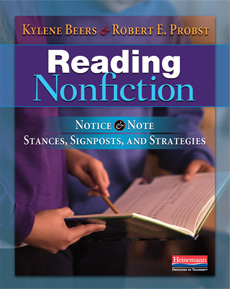 On Monday I was able to attend a PD session that was led by Kylene Beers and Bob Probst, and one of the things they said early in our day struck a chord with me:
On Monday I was able to attend a PD session that was led by Kylene Beers and Bob Probst, and one of the things they said early in our day struck a chord with me:
“Some teachers don’t realize that if they just stay out of the way, the kids who do well will keep doing well. How do we take them further?”
This is such a challenge in our district. Most of our classes are filled with compliant students who generally do what we ask them to do, they show gains in the normal way, and then they move on to the next grade. But is that what we want for our students? Show gains in the normal way? Don’t we want them to gain spectacularly in the time we have them? For most of these students, they will hit a wall sometime. It might be a high school AP class, it might not be until college, and there may be some who can get by until they are out in the “real world” in their job/career. But eventually their act of going through the motions won’t be enough because they won’t be able to truly think deeply and problem solve.
I think we can all agree that nonfiction reading skills are important. But research shows us that strong nonfiction reading skills are one of the highest indicators of success. Unless you’re a literary critic, a novelist, or a teacher (I know, we’re teachers), you probably only read fiction as an escape, but you read nonfiction every day. That means our kids need the tools to be able to dig deep in the text, think through the text, and figure it out.
And here’s one of the amazing things – if you teach the kids the tools, and you give them the time to read a text, think deeply about it, and talk with each other, they will start asking themselves the same questions (or possibly even better questions) than the ones you would be asking. During the PD, Probst said “Our goal should be to get our students to be able to have deep conversations about their reading without needing our help.” Don’t you love the idea of students walking out of the building at the end of the day so tired because of all the deep thinking they have been doing, and you walk out with a smile on your face? Our students should be doing the hard work, not us.
Too often as teachers we spend our time filling in the blanks for our students, and that is hard work! We give them the background knowledge, we ask the questions, and then what do we get back? Low level answers without much deep thinking. When you ask the question, that leads our students to believe that there is one answer, and if they’re lucky they can find it in the back of the book – that’s how school works, and we all know our students can play school. But if students were to ask those same questions, on their own, the conversations will be so much deeper.
Sound good? I think so, but where do we start? Beers and Probst suggested that the initial starting point would be with their 3 main questions:
- What surprised me?
- What did the author think I already knew?
- What changed, challenged, or confirmed what I knew?
As your students are reading, have them code what they read (this means you need something that they can write on, some post its, or a digital format that they can annotate). Beers recommended using an exclamation point for question 1, a question mark for question 2, and the letter c for question 3. Then, after they have read, have them talk in small groups about their thinking.
Next week I plan to go a little deeper with some more of the information that Beers and Probst shared on Monday, but as you get your year rolling, start with the 3 questions. These 3 simple questions will make the reading more personal and relevant. It will push thinking and learning to a much deeper level! (If you want to see a great video of where these questions can push students, scan the QR code on page 88 of your copy of Reading Nonfiction – it’s a 3 minute video clip of 6th graders in a 1:1 classroom).
If you haven’t yet read the book Reading Nonfiction by Beers and Probst, I can’t recommend it highly enough. There is so much there to take your reading instruction to a greater level, and this instruction can take place in ALL classrooms. We all use nonfiction reading skills in our lives, no matter what subject we teach, to help ourselves increase our knowledge and understanding. Let’s help our students develop the skills to be more successful nonfiction readers.
Share your thoughts in the comments below. Have you used the 3 questions in your nonfiction instruction? What changed for your students? What things were great? What struggles did you have? As a community of teachers, we are also a community of learners, and we can learn most from one another!
Laura and Deneice are using these questions with our passport Olympics/behavior inquiry project. The students are responding to current event articles about the troubles in Rio. Using these scaffolding questions has intensified the learning through more in-depth discussions.
LikeLike